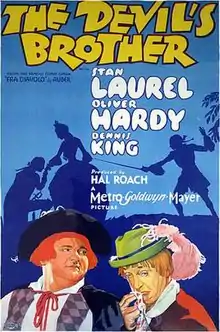| The Devil's Brother | |
|---|---|
 theatrical poster | |
| Directed by | Hal Roach Charles Rogers |
| Written by | Eugène Scribe (libretto) Jeanie MacPherson (adaptation) |
| Based on | Fra Diavolo 1830 opera by Auber |
| Produced by | Hal Roach |
| Starring | Stan Laurel Oliver Hardy Dennis King |
| Cinematography | Hap Depew Art Lloyd |
| Edited by | Bert Jordan William H. Terhune |
| Music by | Auber Leroy Shield |
Production companies | |
| Distributed by | Loew's, Inc. |
Release date | May 5, 1933 |
Running time | 90 mins |
| Country | United States |
| Language | English |
The Devil's Brother (or Bogus Bandits as an Astor Pictures reissue title) or Fra Diavolo outside the U.S. is a 1933 American Pre-Code comedy film starring Laurel and Hardy.[1][2] It is based on Daniel Auber's operetta Fra Diavolo about the Italian bandit Fra Diavolo.
Plot
In the early 18th century, the bandit Fra Diavolo returns to his camp in Northern Italy to tell his gang members about his encounter with Lord Rocburg and Lady Pamela. Disguised as the Marquis de San Marco, he rides with them in their carriage and charms Lady Pamela into telling him where she hides her jewels. He orders his thieves to ride to Rocburg's castle and steal his belongings and Pamela's jewels. Meanwhile, Stanlio and Ollio have also been robbed, whereupon Stanlio suggests to Ollio that they should become robbers themselves. After an unsuccessful attempt to rob a woodchopper, the duo encounters Fra Diavolo, who orders Stanlio to hang Ollio for impersonating him. Diavolo is then informed that his men have stolen Lady Pamela's jewels but have not brought the 500,000 francs hidden by Rocburg.
Diavolo, again disguised as the marquis, takes Stanlio and Ollio with him as his servants to an inn, where he plans to steal Rocburg's 500,000 francs, and where, as Marquis de San Marco, he again romances Lady Pamela. Stanlio and Ollio mistakenly capture Lord Rocburg, who has disguised himself as the marquis in an attempt to win back his wife. Diavolo's attempt to find the francs is, however, foiled after Stanlio drinks a sleeping potion meant for Rocburg. Diavolo's theft of Pamela's medallion is blamed on young Captain Lorenzo, the sweetheart of Zerlina, whose father, Matteo the innkeeper, has decreed that she is to marry a merchant named Francesco the next day. Lorenzo swears he will prove his innocence before Zerlina is forced to marry Francesco.
Meanwhile, Diavolo romances Pamela once again and finds out that Rocburg's fortune is hidden in her petticoat. Just as Diavolo steals the petticoat, Lorenzo finds out his true identity from Stanlio, who is "spiffed" after a visit to Matteo's wine cellar. Lorenzo's soldiers surround the inn and he then duels with Diavolo, whom he bests with a little inadvertent help from Stanlio. The good-natured Diavolo returns the jewels, and when Rocburg will not pay the reward for them to Lorenzo, Diavolo gives Lorenzo the money that he stole from Pamela's petticoat. While the jealous husband rushes upstairs to confront his wife, Lorenzo gives the money to Matteo, thereby saving him from having to sell the inn. Diavolo, Stanlio, and Ollio are then taken away to be shot by a firing squad. When Stanlio takes out his red handkerchief in order to blow his nose, a bull becomes enraged and charges the group, allowing Diavolo to escape on his horse and Stanlio and Ollio to escape on the bull.
Cast

- Stan Laurel as Stanlio
- Oliver Hardy as Ollio
- Dennis King as Fra Diavolo/Marquis de San Marco
- Thelma Todd as Lady Pamela
- James Finlayson as Lord Rocburg
- Lucile Browne as Zerlina
- Arthur Pierson as Lorenzo
- Henry Armetta as Matteo The Innkeeper
- Matt McHugh as Francesco
- Lane Chandler as Lieutenant
- Nina Quartero as Rita
- Wilfred Lucas as Alessandro
- James C. Morton as The Old Woodchopper
- John Qualen as Man Who Owned Bull (uncredited)
- Arthur Stone as Brigand (uncredited)
- Leo White as Tavern Patron (uncredited)
Kneesy-Earsy-Nosey
Kneesy-Earsy-Nosey was the game of coordination and dexterity played by Stanlio in the picture, to Ollio's great frustration. The game, which became a fad shortly after the film's release,[3] consists of clapping the knees, then grabbing one ear with the opposite hand while grabbing the nose with the other hand, again clapping the knees, and then grabbing the other ear with the opposite hand while grabbing the nose with the other hand. Participants attempt to do it with increasing speed. Once coordination has been achieved, one can become extremely fast, and proficiency can be regained even after years of hiatus.[4]
Both "Kneesy-Earsy-Nosey" and "Finger Wiggle"—another game Stan plays in Fra Diavolo—make a brief appearance in Babes in Toyland when Oliver Hardy's character (Ollie Dee) tells Stanley's character (Stannie Dum), in relation to hitting a PeeWee, "If you can do it, I can do it." Stannie then performs both games to disprove Ollie's maxim.
References
- ↑ Variety film review; June 13, 1933, page 15.
- ↑ Harrison's Reports film review; May 20, 1933, page 78.
- ↑ TCM Archives: Laurel And Hardy Collection (DVD) - John J. Puccio
- ↑ Robert Krampf's Experiment of the Week - Kneesy, Earsy, Nosey